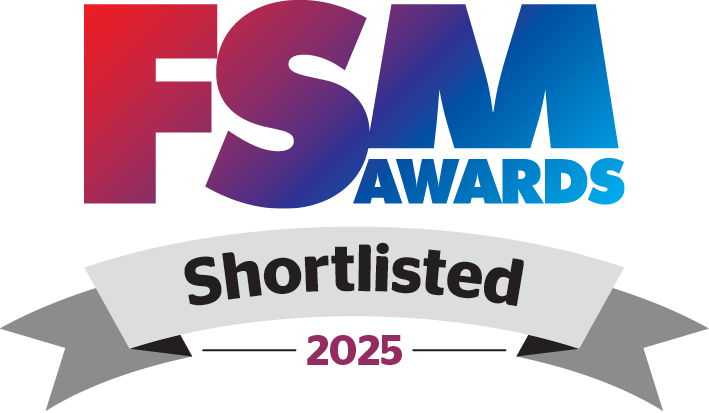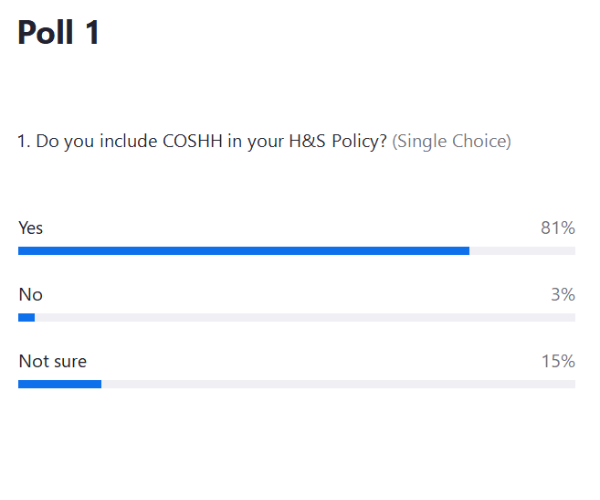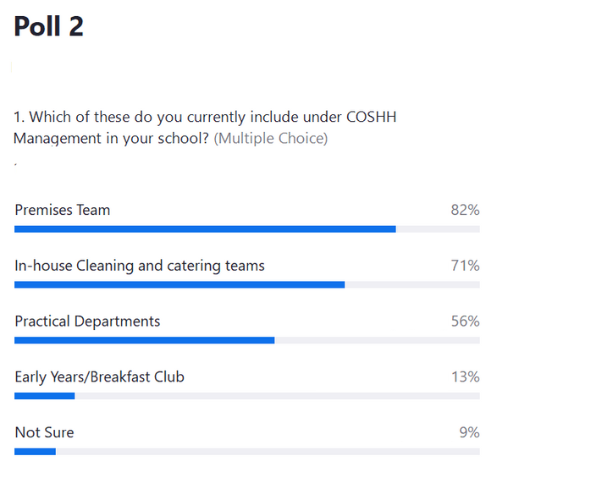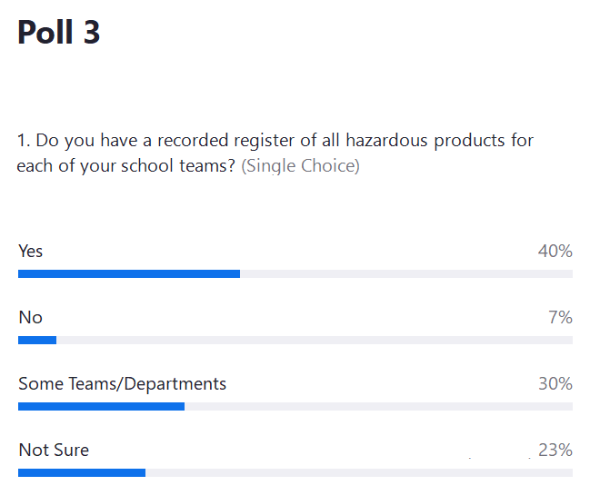COSHH – Beyond the Cleaning Cupboard and Science Department
_1000.png)
This blog is based on Judicium’s Health and Safety ‘Sofa Session’ from the 31st of January, with our resident expert Sarah Crouch CMIOSH. This session focused on: what COSHH applies to; who should be completing COSHH assessments, reviewing, who holds the responsibility for assessing the risks, and what makes them competent to do so; and completing an assessment - discussing what the process involves and how a review process is implemented.
Poll 1
What does COSHH apply to?
The law requires you to adequately control exposure to materials in the workplace that cause ill health. This is the Control of Substances Hazardous to Health Regulations (COSHH) 2002. These regulations exclude Asbestos, Lead and Radiation risks as they are so dangerous, they have their own regulations.
Hazardous substances could be fumes that are breathed in, or liquids, gels or powders that come into contact with eyes or skin. There could also be harmful micro-organisms present that can cause infection, an allergic reaction or are toxic. COSHH doesn’t just apply to hazardous products that come in a bottle or aerosol can, it also includes substances, such as dust produced from an activity, e.g., wood dust in D&T or flour dust in the kitchen.
COSHH Regulations do not apply to generic illnesses contracted in general society such as the common cold or the flu. It must be specific to the work activity and/or the workplace concerned.
To manage harmful substances, you need to start with a policy that identifies the legal remit – which staff and activities require COSHH management processes within the school.
- Managing hazardous substances used directly at a local level.
- Staff who have management oversight to ensure all applicable staff are managing the risks appropriately.
- Non-employees who may be affected by your activities, e.g. members of the public, visitors or contractors who would be affected by dust, fumes, spilt substances, etc.
By identifying, allocating and defining staff roles and responsibilities for managing COSHH, you will also complete a Training Needs Assessment to identify who needs what level of training to be competent in their role.
Training can come in the form of eLearning modules for lower risk tasks or refresher training. We recommend face-to-face training courses for higher risk activities, e.g., premises staff/science/technology teams/in-house catering and cleaning teams.
Poll 2
Who should be completing COSHH Assessments?
Historically COSHH risk assessments were seen as primarily a premises team responsibility which wasn’t applied to the wider school workforce.
When looking at the wide definition of what applies under the regulations, you can see how many different teams will hold their own local responsibilities to complete risk assessments.
As discussed, this can span across several areas:- Premises Team
- Lubricants, fuel, adhesives etc
- Practical Departments (primary and secondary level)
- Science, D&T, Art (ceramics), Food Technology
- Early Years (Including breakfast clubs)
- Infection control protocols
- In-house Cleaning and Catering Teams
- First Aid and Medical Leads
- General school staff
- Use of cleaning products under the staff room sink, hand sanitiser, toilet cleaner in staff toilet.
Line Management
Clarify who line manages the staff who could be exposed to COSHH related hazards. How are they supported as a manager to ensure their staff have the correct assessments in place, complete relevant training and continue to review best practice for safe use?
Contractors
When a school has external cleaning or catering contractors, you need ensure a COSHH folder with risk assessments, training, product information, etc, was provided and is stored on site. It should replicate everything set out for an in-house team to do, but it is managed by the contracted company.
The same applies to contractors who are employed to complete maintenance work or provide activities/clubs.
Example 1
A roofer using water-proof sealant on a new flat roof will need to provide all the relevant COSHH risk assessment information to show you how they will use, manage and dispose of the product safely without exposing themselves or your occupants to hazards.
Example 2
A breakfast club is run by an external provider who is contracted to deliver a weekday club to eligible pupils. This could include cleaning materials, food hygiene controls and first aid supplies that need to be considered.
It's important to know who is responsible within your school, academy, or Trust for ensuring external contractors have the correct arrangements and records in place for COSHH management.
Poll 3
How do we complete assessments?
Create a COSHH Register
Creating a COSHH Register of the products you have and what processes pose a hazard is essential to keeping track of what your teams are managing.
NB: For Judicium Health and Safety clients, we can provide you with a template for this.
Safety Data Sheets (Used to be called MSDS)
Every product that is purchased from a supplier which poses a risk is legally required to have a Safety Date Sheet. It details all generic information from the manufacture to use and dispose of the product. This is defined by a GB CLP Regs (Classification, labelling and packaging) by the red diamond symbols on the product label.
NB: If it has one or more red diamond CLP symbols, a COSHH risk assessment is required.
Risk Assessment
Risk assessments should be bespoke to the activity and product concerned. A COSSH risk assessment should be specific to the product or substance being assessed. You will use the generic information in the SDS to write a tailored, specific assessment of how your team will use the substance. This will include any individual requirements for team members such as allergy controls.
NB: For Judicium Health and Safety clients, we can provide you with a template for this.
How do I use it safely
Defining safe use will include information such as dosing requirements for mixing, PPE provisions, ventilation requirements, and maximum exposure times.
How do I store it safely
Storage information should include bunding requirements to catch leaks, identifying substances to be kept separate so they do not react with each other, correct containers, and appropriate materials of containers. No Unlabelled Reused Cola Bottles!
Example: An old Ribena bottle is used to store some extra purple disinfectant. This is dangerous as it could be picked up by anyone unknowingly.
How Do I dispose of it safely
Safe Data Sheets will define when a substance is safe to dispose of in a standard drain (if it is low risk/water soluble) or through specialist waste services.
-
Paint – Local Authority Disposal or your licensed waste carrier with agreement
-
White Spirit from Art – Licenced waste carrier with specific arrangements
-
Science department chemicals – Specialist hazardous waste carrier
3 Top Tips
- Your COSHH Policy must identify staff roles and responsibilities.
- Ensure you have a COSHH register of products/substances that is reviewed annually at minimum.
- Ensure COSHH risk assessments are recorded and reviewed annually.
- A great way manage this is to split the job across the teams who wrote them and disperse the reviewing process across the year, rather than rushing to review all RAs at the end of the year.
Additional Info:
COSHH Live Training at your School/Trust
COSHH eLearning module as part of our H&S eLearning package
The Health and Safety Service is also providing accredited training courses, including eLearning with specific modules ranging from courses designed for premises managers and SLT to all staff offerings and fire warden training: https://www.judiciumeducation.co.uk/elearning
We also offer live, exclusive training options https://www.judiciumeducation.co.uk/training
To review Judicium’s forthcoming sofa sessions please click here.
Follow us on Twitter - @JudiciumEDU
© This content is the exclusive property of Judicium Education. The works are intended to provide an overview of the sofa session you attend and/or to be a learning aid to assist you and your school. However, any redistribution or reproduction of part or all of the contents in any form is prohibited. You may not, except with our express written permission, distribute or exploit the content. Failure to follow this guidance may result in Judicium either preventing you with access to our sessions and/or follow up content.
Related content
.png)
This blog is based on Judicium’s Health & Safety and SEND session on 26th November with resident expert India Cottenden
.png)
This blog is based on Judicium’s Food Safety Sofa session on 12th November with resident experts Sue Roberts and Tracey Killick

This blog is based on Judicium’s Health and Safety ‘Sofa Session’ on the 15th of October, with our resident expert Mike Wright.

This prestigious award celebrates our commitment to delivering expert, education-specific Health & Safety support that lifts the burden for school teams while raising safety standards across the sector.

This blog is based on Judicium’s Health and Safety ‘Sofa Session’ from 18th June, led by resident expert , Mike Wright, CMIOSH. This session focuses on the control of substances hazardous to health (COSHH) and their relevance in school settings, how assessments should be undertaken and what staff could be at risk.

Discover why Judicium has been shortlisted for Fire Safety Consultancy of the Year at the 2025 FSM Awards, recognising our expert support for schools and trusts in delivering sector-specific, compliant, and practical fire safety solutions.




Sofa Sessions | H&S